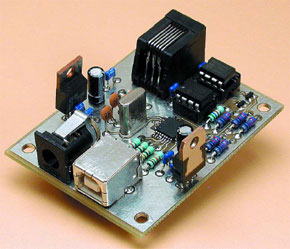USB/I²C interface
I-square-C rules...

This is a MEMBER ONLY article. You need a subscription to read this article.
- Access to Elektor archive and 5,000+ Gerber files
- Receive up to 8 magazines per year (digital and/or paper)
- 10% discount in the Elektor store
Available from €4.95 per month.
What is Members Only
Elektor is committed to providing high-quality content on electronics, catering to tens of thousands of paying members. As part of this commitment, Elektor has launched Premium, an initiative that offers exclusive online articles to members sometimes even before they appear in the magazine.
Every day, members can access in-depth articles that showcase the best of Elektor's premium content.
This initiative aims to reward members with early access. Once logged in, members can easily enjoy this exclusive content and engage in discussions about featured projects. While Premium adds to the existing resources available, Elektor will continue to provide a wealth of free information.
Join the Elektor community today to take advantage of Premium and other benefits!
Materials
Gerber file
CAM/CAD data for the PCB referred to in this article is available as a Gerber file. Elektor GREEN and GOLD members can exclusively download these files for free as part of their membership. Gerber files allow a PCB to be produced on an appropriate device available locally, or through an online PCB manufacturing service.
Elektor recommends the Elektor PCB Service service from its business partner Eurocircuits or AISLER as the best services for its own prototypes and volume production.
The use of our Gerber files is provided under a modified Creative Commons license. Creative Commons offers authors, scientists, educators and other creatives the freedom to handle their copyright in a more free way without losing their ownership.
Extra info / Update
In the circuit diagram in Figure 1, the outer connection of the mains adapter socket is shown connected to ground while the centre pin carries the positive supply voltage. On the PCB designed for the project, these connections are the other way around.
Even if the circuit diagram does not show it explicitly, the P82B715PN is a bidirectional component (see www.semiconductors.philips.com/pip/P82B715PN.html). Consequently, nothing changes when compared to the circuit without the P82B715PN. Incidentally, controlling devices over the I2C bus always requires a bidirectional interface.
Component list
R1 = 15kOhm
R2,R3 = 33Ohm
R4 = 1kOhm5
R5,R6,R8,R9,R10 = 10kOhm
R7 = 5kOhm6
R11,R12 = 330Ohm
Capacitors:
C1,C4 = 1µ F 16V radial
C2,C3,C7-C11 = 100nF
C5,C6 = 22pF
Semiconductors:
D1,D2 = BAT85
D3 = 1N4001
IC1 = TUSB3410 (Digikey # 296-12699-ND)
IC2 = 24LC64, programmed, order code 040334-21
IC3 = LM1117-3.3 or LD1117V33C (Digikey # 497-1492-5-ND)
IC4 =7805
IC5 = P82B715PN (Farnell # 559-258; RS Components # 821-784)
T1,T2 = FDV301N (Farnell # 995-848; RS Components # 354-4907)
Miscellaneous:
K1 = USB-B connector, angled, PCB mount (Farnell # 152-754)
K2 = mains adapter socket PCB mount
K3 = 6-way RJ-11 connector (Farnell # 393-8359)
X1 = 12MHz quartz crystal
USB cable
PCB, order code 040334-1 (see Readers Services page)
Disk, project software, order code 040334-11 or Free Download



Discussion (0 comments)